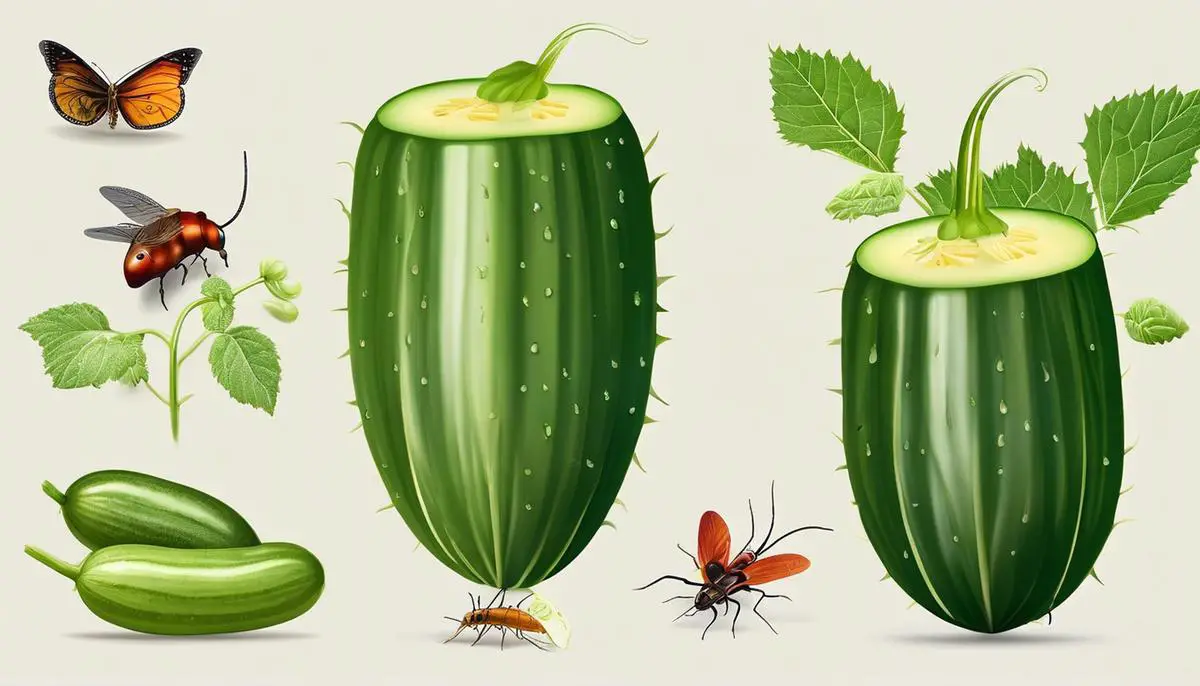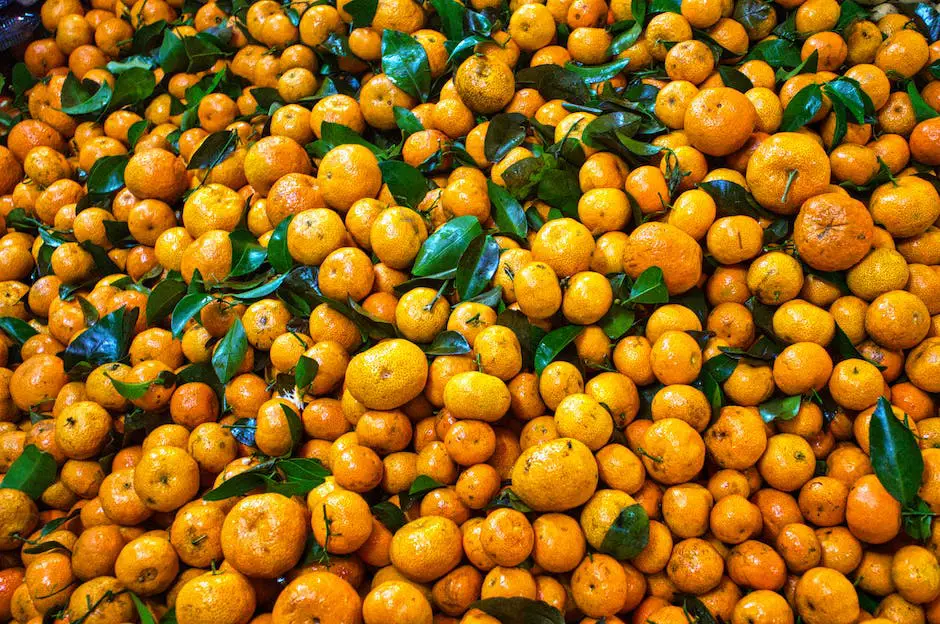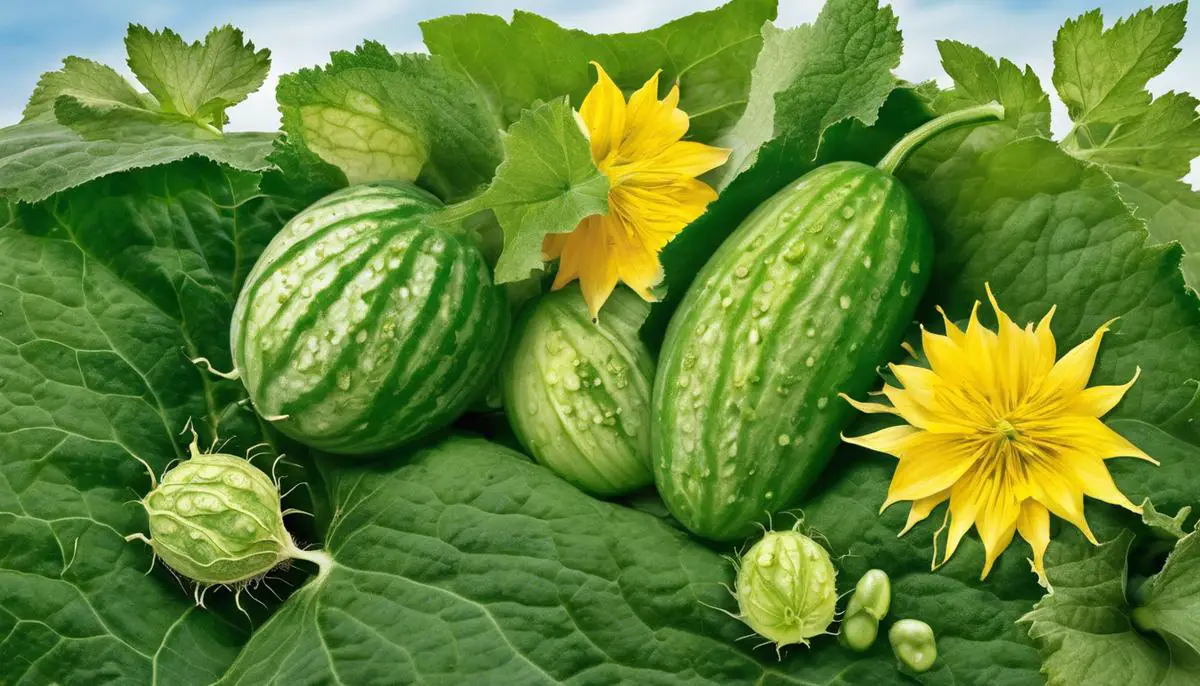When nurturing fruits and vegetables like cucumbers, the joys of harvest can easily be tainted by the onslaught of pests and diseases. This discourse aims to demystify two prominent cucumber growing challenges: pests and diseases. The narrative commences with identifying the most common pests that launch an offensive on cucumber plants, including aphids, cucumbers beetles, and whiteflies among others. Each pest’s distinguishing features, behaviors, and the damage they unleash on plants are underscored.
Subsequently, the spotlight will be cast on environmentally friendly pest control techniques such as crop rotation, use of natural predators and barriers, as well as organic and chemical pesticides. Then we steer the conversation towards familiarizing readers with the most common diseases that spell disaster for cucumber plants, including powdery mildew, downy mildew, bacterial wilt, and Fusarium wilt. Lastly, we delve into disease management strategies focusing on preventative and reactive measures, with the ultimate goal of furnishing readers with adequate knowledge and resources to combat these hurdles effectively.
Reader Poll: What online courses would interest you?
Identifying Common Cucumber Pests
Comprehending Cucumber Pests: Identification and Implications
Agricultural pursuits often have a wealth of challenges merely lying in wait, a reality that is indubitably evident amid the production of cucumbers. Pests constitute one of the most prominent of these problems, and the identification and understanding of these crop-nibbling antagonists is crucial. This article illuminates the most common pests associated with cucumber plants and offers insights into their identification.
Cucumbers, Cucumis sativus, are susceptible to a medley of pests, including insects, mites, and nematodes. This troupe of pests not only vary in their nature, but also the degree of damage they inflict upon the plant.
Aphis gossypii, colloquially referred to as the ‘cotton aphid’ or ‘melon aphid’, is a ubiquitous adversary of cucumber plants. Identification of these pests is traditionally reliant on observation of physical attributes – they usually possess a green, yellow, or black body, and are routinely found on the plant’s underside. Aphids are notorious for their tendency to cause stunted growth, leaf curling, and a generally diminished vigor in cucumber plants by sucking the sap.
Subscribe to our newsletter!
Furthermore, we find the array of beetles like the striped cucumber beetle, Acalymma vittatum, and the spotted cucumber beetle, Diabrotica undecimpunctata. As their names suggest, these pests are easily recognized by their striking body markings. The striped cucumber beetle, for instance, bears characteristic longitudinal yellow and black stripes on its body. Both beetles possess an insatiable appetite for cucumber plant leaves, stems, and fruit, making them extremely destructive to plant productivity.
The two-spotted spider mite, Tetranychus urticae, typically reveals its presence through the manifestation of yellow or white spotting on cucumber plant leaves. On closer examination, their minute, oval-shaped, and green-to-yellow bodies can be discerned on the leaf surface. The damage they wreak on cucumbers includes leaf and fruit discoloration, defoliation, and an overall decline in plant health.
Root-knot nematodes, Meloidogyne species, are soil-borne microscopic roundworms that form galls or ‘knots’ on the roots of cucumber plants which, divulge their presence. The consequence? Stunted growth, yellowing of leaves, wilting, and ultimately, a lean harvest.
In the true spirit of scholarly exploration it is pertinent to impress upon the necessity of pest identification. Identification is merely not about attaching names to pests. It is indeed a proactive step in integrated pest management. A comprehensive understanding of the enemy is the first stride in formulating combat strategies, a fact as true in agriculture as it is on the battlefield.
With the entities uncovered and their behaviors elucidated, the green-thumbed individuals among us stand well-equipped to deal with cucumber pests, tackling them with a sophistication steeped in scientific truth. As is common in the scientific realm, the secret rests not in knowing everything, but in seeking to understand more.

Pests Control Techniques
Unveiling Effective Techniques for Controlling Common Cucumber Pests
The realm of agricultural pest management, specifically in the context of cucumbers, is riddled with challenges primarily due to the array of pests like the cotton aphid, cucumber beetles, spider mites, and root-knot nematodes that severely impact yield and production. Their identification and understanding gain paramount importance in devising effective pest management strategies. The pulsating question that now posits is “What are the most successful techniques for controlling common cucumber pests that ensure plant health preservation?”
The answer lies in the principle of Integrated Pest Management (IPM) – a multifaceted, ecological approach, which integrates diverse techniques to manage pest populations adroitly, minimizing both economic and environmental damage.
Among the techniques recommended for control is Crop rotation, demonstrated scientifically as a potent method to disrupt the lifecycle of pests, particularly for root-knot nematodes. By alternating crops that are less suitable for these pests, populations can be considerably reduced, mitigating adverse effects on subsequent cucumber plantations.
Trap cropping is another effective strategy in IPM. This involves planting a more attractive crop type near the cucumber crops to lure pests away. For instance, radish crops have showcased good results in attracting cucumber beetles, considerably reducing their impact on cucumber plants.
The implementation of Biological Control methods holds tremendous potential in pest management. Natural predators or parasites of pests act as biological control agents. Ladybugs or lacewings have proved to be effective predators of aphids while predatory mites can keep spider mite populations in check. Furthermore, fungi like Paecilomyces lilacinus and bacteria like Bacillus firmus showcase nematicidal properties that can effectively control nematode populations.
Insect-resistant varieties of cucumber are another valuable tool in pest management. Breeding for pest resistance has led to cucumber cultivars displaying the ability to resist pests such as melon aphid and striped cucumber beetle, thereby reducing pesticide reliance.
Behavioral control methods are also proven beneficial. Techniques such as pheromone trapping can effectively control cucumber beetle populations. These traps are laced with the specific pheromones that female beetles emit, enticing male beetles who then get trapped, thus curbing their mating and reproduction.
Interestingly, Botanical pesticides like neem oil, extracted from the neem tree, exhibit insecticidal properties with low toxicity to non-target organisms, making them an environmentally-friendly choice for pest management. It’s particularly useful in controlling aphid and spider mite populations.
Although several effective techniques have been unraveled, it’s essential to pair these strategies intelligently, considering each garden or farm’s unique characteristics. Such an integrated method ensures effective pest management, consequently helping the cucumber plants to blossom fully, unhindered by the crippling effects of daunting pests. The quest for achieving a perfect balance between high crop yield and minimal environmental impact continues to fascinate researchers worldwide, illuminating the path towards sustainable agriculture.

Common Cucumber Diseases
In addition to the pests highlighted in the prior discussion, cucumber plants also endure disease afflictions that can significantly impact productivity and health. Understanding these diseases, their identification, and management strategies are indispensable for maintaining productive crop yield.
An especially prevalent disease among cucumber plants is Anthracnose, caused by the fungus Colletotrichum orbiculare. It presents itself as water-soaked spots on leaves, stems, and fruits which later turn dark and necrotic. These lesions can enlarge under conducive weather conditions favoring high humidity and frequent rainfall. Fortunately, it can be managed by using resistant cultivars, proper sanitation procedures, regular use of fungicides, and crop rotation.
Just as insidious is Downy Mildew, caused by the water mold Pseudoperonospora cubensis. The checkerboard yellowing pattern on the upper leaf surface is a typical identification marker. In the damp morning hours, you can observe faint purplish-gray growth on the leaf undersides, explaining its name. Strict sanitation procedures, appropriate fungicide applications, and planting resistant cultivars can help control the spread of Downy Mildew.
Powdery Mildew, caused by the fungus Podosphaera xanthii, is yet another key disease affecting cucumbers. The name derives from the white, powdery fungal growth that appears on both sides of the leaves. The disease reduces plant vigor, impairs fruit quality, and can decimate yields if left unchecked. Interestingly, different strains of the fungus exist, which can overcome the resistance in some cucumber varieties. Thus, effective management hinges on multi-faceted strategies including the use of resistant cultivars, fungicides and maintaining good airflow through correct plant spacing to minimize humidity.
Bacterial wilt, triggered by the bacterium Erwinia tracheiphila, is a serious challenge particularly in regions where cucumber beetles, its primary vectors, are abundant. Symptoms include wilting of individual leaves shifting to whole vines, and eventual plant death. The bacterium inhabits the beetle’s gut and is transmitted to the plant through feeding damage. Therefore, management strategies aim at controlling beetles using resistant varieties, crop rotation, and strategic pesticide applications.
Angular leaf spot, incited by the bacterium Pseudomonas syringae pv. lachrymans, is typically observed as water-soaked lesions on leaves, giving a characteristic angular appearance due to the veins limiting lesion expansion. This bacterium is seed-borne and can persist in plant residue. Therefore, sanitation, seed treatment, crop rotation, and the use of resistant varieties are important in disease management.
Fusarium wilt, incited by Fusarium oxysporum f. sp. Cucumerinum, is a soilborne disease that can cause significant yield loss. The pathogen affects the vascular system, causing wilting, stunting, and yellowing of leaves typically starting from the lower part of the plant. Because the fungus can persist in the soil for several years, the use of resistant varieties and crop rotation are crucial for management.
Therefore, an understanding of these diseases, their early detection, and embracing integrated disease management strategies such as resistant cultivars, sanitary measures, crop rotation, and appropriate use of pesticides are essential in sustaining productive and healthy cucumber crops.

Disease Management Measures
A notable extension of the challenges posed by pests to cucumber farming is the concurrent danger of plant diseases. Indeed, these diseases are often caused by microscopic organisms such as fungi, bacteria, and viruses which in some cases, may be vectored by the insects mentioned earlier. Management of these plant diseases therefore not only necessitates an understanding of their biology, but also the biology of the pest population in the region. Here, the focus will be on a select number of these diseases that are particularly common to cucumber plants: anthracnose, downy mildew, powdery mildew, bacterial wilt, angular leaf spot, and Fusarium wilt, along with insights on responsible strategies for their management.
Anthracnose, triggered by the fungus Colletotrichum orbiculare, is one such menace to cucumber plants. It lays siege to the leaves, stems and fruits of the cucumber plants causing brown, water-soaked lesions. Similarly unfavorable conditions are enforced upon cucumber plants by water molds like Pseudoperonospora cubensis that cause downy mildew. An infested plant is marked by angular yellow-green spots on the upper leaf surfaces and purplish-gray spore masses on the lower leaf surfaces.
Meanwhile, powdery mildew engendered by Podosphaera xanthii, presents symptoms interestingly dissimilar to its counterparts—heavily white, powdery spots that may cover leaves, stems, and even fruits of infected plants. However, perhaps more egregious is Erwinia tracheiphila, a bacterium that causes bacterial wilt, a rapid and destructive disease that is often vectored by the striped or spotted cucumber beetle. E. tracheiphila impedes the water conducting vessels of the plant leading to wilting and eventual plant death.
Perhaps even more troubling to the unsuspecting cucumber plant is Pseudomonas syringae pv. lachrymans, the causative agent of angular leaf spot. It strikes with a dual blow, causing water-soaked spots on the leaves which later turn necrotic, and a white, gummy exudate under humid conditions. Lastly, Fusarium wilt, incited by Fusarium oxysporum f. sp. cucumerinum, wreaks havoc, causing vascular discoloration and typically unilateral leaf wilting.
Effective disease management strategies are a compendium of approaches that can be distilled into four categories: usage of resistant cultivars, sanitation, and crop rotation, backed by judicious and limited use of pesticides. Selecting disease-resistant cultivars, those that have been bred for resistance to specific diseases, serves as the first line of defense in the antisepsis of cucumbers.
Sanitation involves removal and destruction of infected plant debris, disinfecting tools, and creating an environment less conducive to disease spread. Crop rotation, where cucurbit crops are not grown in the same area for two to three years, helps diminish the amounts of soilborne pathogens; this practice in conjunction with the use of cover crops can additionally improve soil health.
Pesticide usage, often viewed as the panacea to all problems in agricultural contexts, should be limited to situations where environmental conditions and pathogen populations pose a significant risk to the crop. Over-dependence on pesticides not only leads to the development of resistant pathogen populations but can also disadvantageously impact the natural biodiversity of beneficial organisms.
In conclusion, tackling these diseases must be exercised with strategic poise; it’s not merely about eradicating the microscopic foes, but also sustaining the broader ecosystem. In the harmonization of these strategies, lie the key components to not only successfully combating cucumber diseases, but also advancing toward sustainable food production systems. The understanding and management of these diseases represent a cog in the expansive wheel of sustainable agricultural practices, an essential step towards feeding the world’s growing population.

Deciphering the different pests and diseases that threaten cucumber plants can seem daunting, but with the right information, it is a task that can be effectively managed. An understanding of pest characteristics, behaviors and the havoc they wreak on plants, bolstered by knowledge of environmentally-friendly control techniques, is a formidable weapon in the fight against these destructive organisms.
Recognizing the symptoms and signs of common cucumber diseases, in conjunction with an appreciation of disease management measures, equips you to act swiftly and effectively to protect your crops. It is our hope that this overview inspires a more confident approach to cucumber cultivation, ultimately yielding healthier and more prolific crops.

